Module 3
1. Module 3
1.42. Page 2
Module 3—Electrical Phenomena
 Explore
Explore
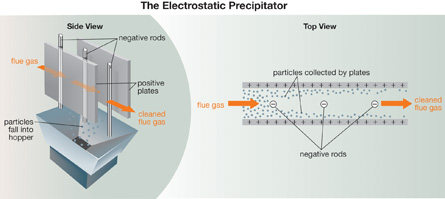
An electrostatic precipitator works using positively charged parallel plates, which sandwich negatively charged metal rods that hang between the plates. As the particles in the flue gas pass the negatively charged rods, the particles pick up negative ions and become negatively charged. These negatively charged particles are then attracted to the positive plates where they are collected. By the time the flue gas has passed through a long column of rods and plates, over 99% of the particulate matter has been removed. Periodically, the large positive plates are rapped with automated hammers, causing the particles to drop into the hoppers below the plates.
The pattern of the electric field lines within an electrostatic precipitator is a combination of the patterns formed by field lines between parallel plates with the patterns that surround negative sources.
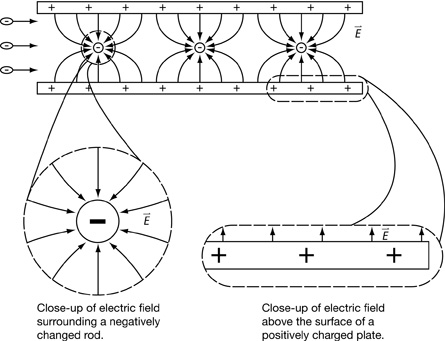
 Self-Check
Self-Check
SC 1. Classify the pattern of electric field lines close to the negatively charged rod as being either "uniform" or "radial.”
SC 2. Classify the pattern of electric field lines close to the positively charged plates as being either “uniform” or “radial.”
 Self-Check Answers
Self-Check Answers
SC 1. The electric field lines close to the negatively charged rod are radial since they are aligned along lines that converge at the centre of this circular pattern.
SC 2. The electric field lines close to the positively charged plates are uniform because the field lines are parallel and evenly spaced.
The Motion of Charged Particles in Radial Electric Fields
To develop an understanding of how an electrostatic precipitator works, you will first take a look at the motion of charged particles in radial electric fields.
 Read
Read
You can learn how the motion of charged particles can be analyzed in non-uniform electric fields by reading pages 570 and 571 of your textbook. Pay special attention to the way that the law of conservation of energy is used in “Example Problem 11.10.”
 Self-Check
Self-Check
SC 3. Explain why the equations for accelerated motion could not be used for situations like the one described in “Example Problem 11.10.”
SC 4. Solve “Practice Problem” 2 on page 571 of your textbook.
 Self-Check Answers
Self-Check Answers
SC 3. The equations for accelerated motion describe motion when the acceleration is constant. In cases like “Example 11.10,” the electrostatic force acting on the particle is much stronger closer to a point source than it is further away. Applying Newton's second law of motion, the acceleration resulting from this force will also be much stronger closer to the source than at locations further away. Since the acceleration is not constant, the equations developed to describe uniformly accelerated motion cannot be used for situations like this.
SC 4.
Given
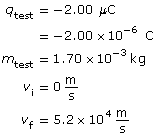
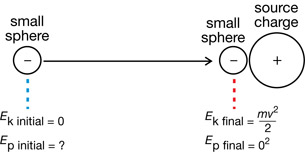
Required
The electric potential energy lost by the test charge.
Analysis and Solution
Initially the small test sphere is at rest so it has zero kinetic energy. However, at this location the system has electric potential energy relative to the source charge because it takes work to move the test charge away from the source charge. Since the system is conservative this loss of electric potential energy when the test charge moves toward the source is equal to the gain in kinetic energy.
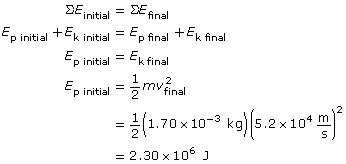
Paraphrase
The test charge lost 2.30×103 J of electrical potential energy.
 Did You Know?
Did You Know?

© Germany Feng/shutterstock
Many of the air-cleaning systems that you can buy for your home are actually small electrostatic precipitators. In these home units, a small fan forces air to pass by a long, negatively charged wire. Tiny particles in the air pick up negative ions and become negatively charged. As the stream of air passes by positively charged collection plates, the negative particles are attracted to the plates and are removed from the air. However, unlike the huge installations at power plants, there are no hammers to rap the collection plates and cause the collected particles to fall into a hopper. In these smaller home systems, the unit has to be unplugged before the plates can be removed and cleaned by hand.